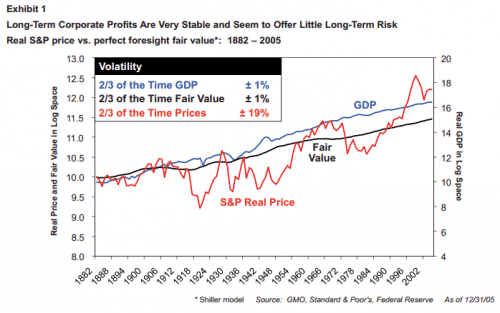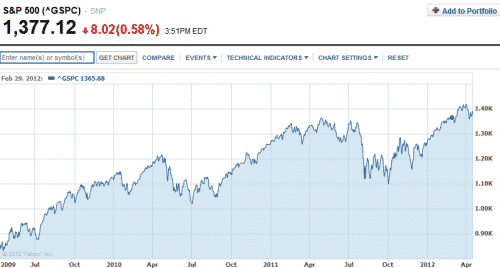Grantham: Missing a bull market is a dismissible offense
The central truth of the investment business is that investment behavior is driven by career risk. In the professional investment business we are all agents, managing other peoples’ money. The prime directive, as Keynes knew so well, is first and last to keep your job. To do this, he explained that you must never, ever be wrong on your own. To prevent this calamity, professional investors pay ruthless attention to what other investors in general are doing. The great majority “go with the flow,” either completely or partially. This creates herding, or momentum, which drives prices far above or far below fair price. There are many other ineffciencies in market pricing, but this is by far the largest. It explains the discrepancy between a remarkably volatile stock market and a remarkably stable GDP growth, together with an equally stable growth in “fair value” for the stock market. This difference is massive – two-thirds of the time annual GDP growth and annual change in the fair value of the market is within plus or minus a tiny 1% of its long-term trend as shown in Exhibit 1. The market’s actual price – brought to us by the workings of wild and wooly individuals – is within plus or minus 19% two-thirds of the time. Thus, the market moves 19 times more than is justified by the underlying engines!
-Jeremy Granthan, Quarterly Newsletter, April 2012
Here’s the chart he gives, demonstrating the volatility of herding.
It’s an unforgivable sin in the investment management business to miss a bull market. You’re in the bottom quartile sucking wind while everyone else is cleaning up? That’s when the redemptions come fast and hard. And the next thing you know you’re packing your things and being escorted by security to the door. Who wants to be that guy? No one. That’s what herding is all about.
But hold on a minute. There are two sides to this coin. Let’s reach back to March, April and May of 2009 when the global economy seemed on death’s door and people were scared, selling into a market that seemed to just drop and drop every day. The S&P500 bottomed at 666, a level that was deeply, deeply oversold for exactly the reasons Grantham gives above. I fully expected them to go even lower for exactly that reason. Here’s what I wrote about Grantham back then:
"Jeremy Grantham, who is chief investment strategist of Grantham Mayo Van Otterloo & Co and manages over $85 billion is telling clients to get out of cash…we are in the overshoot phase of the bear market, with most of the decline being sentiment driven. Could we go to 450 on the S&P, yes (I fully expect us to go lower still after a bear market rally). But, in going lower, the market would make more and more value plays apparent."
–More bullishness from Jeremy Grantham, 10 Mar 2009
Actually that was almost right at the bottom. So stocks did not go lower; the values were obvious enough to lift markets from that day forward.
But Fund managers who were caught up in the madness that led to 666 didn’t want to be in the bottom quartile, holding on to loser investments that were getting clobbered. That’s sure fire way to get escorted by security to the door and out on the street – during a huge recession no less. So you sell, with everybody else. That’s what Grantham is talking about.
At some point though the momentum switches. It just happens. The data start to get less bad and buyers like Grantham start to pull the trigger. At some point, the momentum shifts. None of us knew the Great Financial Crisis bottom was mid-March 2009 at the time. Just like none of us knew exactly when the tech bubble was going to burst, although we knew it would.
I remember well that Grantham started to sell early and watched as he underperformed. Jeremy Grantham is a big believer in reversion to the mean. He is a value investor and his analysis indicated that traditional stock portfolios were well overvalued by any value metric. So he began taking his clients out of stocks in 1998 and 1999 just as the market zoomed. The redemptions started rolling in as herd behavior and mania was all around. Grantham lost 40% of his funds under management during that blow off peak to the mania. That’s how it works, folks.
But Grantham stuck to his guns and was proved right when the market crashed starting in March 2000. Remember, almost no one has the professional latitude or fortitude Grantham had during the tech bubble.
What about this cyclical bull market? Here’s how I characterised it in April 2009 just after it began:
This is a fake recovery because the underlying systemic issues in the financial sector are being papered over through various mechanisms designed to surreptitiously recapitalize banks while monetary and fiscal stimulus induces a rebound before many banks’ inherent insolvency becomes a problem. This means the banking system will remain weak even after recovery takes hold. The likely result of the weak system will be a relapse into a depression-like circumstances once the temporary salve of stimulus has worn off. Note that this does not preclude stocks from large rallies or a new bull market from forming because as unsustainable as the recovery may be, it will be a recovery nonetheless.
[…]
…This is a fake recovery underneath which many problems remain.
Nevertheless, banks are going to earn a lot of money and that is bullish for their shares – at least in the medium-term. Yes, the stock market is overbought right now. However, if banks put together some decent earnings reports over the next few quarters, their shares will rise.
Furthermore, if the banks can earn enough, this cyclical recovery will have legs as banks will then have enough capital to resume lending and that is supportive of the broader market as well.
The S&P500 was at 858 when I wrote that. It is now well over 1300. If you missed this three-year bull market, you lose and that’s a dismissible offense. But, as I said in 2009, I don’t believe for one second that this recovery is a ‘real’ recovery. As soon as we have another recession, all of the problems – the overindebted households, the excess housing inventory, the excess auto capacity, the still bubblicious Australian and Canadian property markets – will come out of the woodwork. It will be what I call a Shiller double dip. That means bad things for shares, which are overvalued on a cyclically adjusted PE basis or by a Tobin Q ratio metric in my view.
How do you deal with that?
Jeremy Grantham gives a good answer, recounting the tech bubble story I told you:
You apparently can survive betting against bull market irrationality if you meet three conditions. First, you must allow a generous Ben Graham-like “margin of safety” and wait for a real outlier before you make a big bet. Second, you must try to stay reasonably diversified. Third, you must never use leverage. In my personal opinion (and with the benefit of hindsight, you might add), although we in asset allocation felt exceptionally and painfully patient at the time, we did not in the past always hold our fire long enough or be patient enough. It is the classic failing of value managers (and poker players for that matter) to get impatient and bet too hard too soon. In addition, GMO was not always optimally diversified. We are generally more cautious (or, if you prefer, “more experienced”) now than in 1998 with respect to, for example, both patience and diversification, and at least we in asset allocation always stayed away from leverage. The U.S. growth and technology bubble of 2000 was by far the biggest market outlier event in U.S. market history; we had previously survived the 65 P/E market in Japan, which was perhaps the greatest outlier in all important equity markets anywhere and at any time. These were the most stringent tests for managers, and we were 2 to 3 years early in our calls in both cases. Yet we survived, although not without some battle scars, with the great help that we did, in the end, win these bets and by a lot. Hypothetically, resisting the temptation to invest too soon in 1931 may have been a tougher test of survival in bucking the market. Luckily we, and all value managers, were not around to be tempted by that one.
In sum, Grantham says you can survive an irrational market by
- allowing for a generous Ben Graham-like “margin of safety” and waiting for a real outlier before you make a big bet
- staying reasonably diversified
- never using leverage
For me, this is the central thesis of Grantham’s quarterly letter. I suggest you read the whole thing at his website. There is a lot more in there and it is another spectacular piece of investment analysis.
Source: Grantham, Mayo, Van Otterloo & Co., LLC
P.S. – Note the following quote on stock picking from the article as it is important: because asset class selection packs a more deadly punch in the career and business risk game, the great investment opportunities are much more likely to be at the asset class level than at the stock or industry level [emphasis in original].


The comparison of GDP with the SP trends seems to be a bit tendentious, unless the “SP” here means the total sales or total earnings or total capitalization of all or most SP stock, which may be a proxy for some measure of the value of USA business aggregate.
But the quote refers to the S&P500, and is that’s what being graphed it does not make sense, because it is an index and the index has no reason to follow USA GDP, in particular since the S&P500 started to contain many large transnational businesses who have more than half their sales outside the USA.
Indeed there is little obvious correlation until the 60s bubble and the then again the 90s bubble. Stock indices seem tome to correlate more with loose money or credit conditions than GDP, and then there is the argument that they seem to correlate best in recent decades with the number of people 45-65.
Note: the overall argument about highly correlated investment decision driving volatility seems fair, illustrating it with a baseline of GDP vs. SP is a bit iffy.